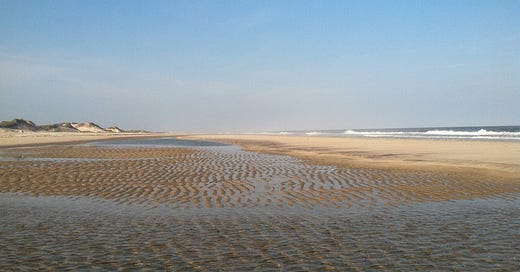Art, artifice, and artificiality (sea glass)
Very few people want the sea-shredded plastic caps and bottles that litter the high-tide line round the world.
TikTok is a horrendous waste of my time and is absolutely rotting my brain and turning it into Swiss cheese, but it has also introduced me to the people who make “sea glass” by breaking bottles and putting the shards into a rock tumbler to manufacture in mere days what would otherwise have been accomplished by water and sand over weeks, months, or years.
Which of course made me wonder if there was a looming sea glass shortage—perhaps because more and more substances are packaged in plastic instead of glass, so there’s less raw material available for the all “natural” sea glass? After all, very few people want the sea-shredded plastic caps and bottles that litter the high-tide line round the world.
Naturally, I wanted to know what other people had to say about this phenomenon, which is how I learned about the International Sea Glass Association, whose primary mission is “to educate collectors and creators on the characteristics and significance of genuine sea and beach glass.” (And, yes, that organization confirms there is a shortage, although mostly due to greater demand, not necessarily a smaller supply.)
Unfortunately, even if there was a market for plastic beach trash, it would barely make a dent in the millions of metric tons of plastic waste that enter the ocean every year.
Reading list
Trail magic: Bing Lin returned to the Pacific Crest Trail this year to finish up a 500-mile section he had to skip due to snow during his 2019 thru-hike, and is writing a series of articles about his section hike and the various climate and environmental issues that are impacting the trail. Of particular interest: His proposal to direct the generosity of spirit exhibited by trail angels towards climate and environmental crises. [Inside Climate News, h/t Dawn Stover]
Larger than life: I was not expecting so many underwater shots when I clicked on this photo essay of old-growth forests, but as the photographer points out, forests, streams, and rivers are intimately connected: “In Oregon’s Coast Range, stream flow was found to decrease by 50% on tree plantations that were cut on 40- to 50-year rotations.” [Ben de la Cruz interviews photographer David Herasimtschuk for NPR]
Hot, hot, hot: Death Valley saw its hottest-ever meteorological summer (June - August) this year, with an average 24-hour temperature of 104.5 degrees Fahrenheit, which is an even stronger climate change signal than the daily temperature record. “When you look at a whole summer period, that’s more indicative of climate change,” Matt Woods, a meteorologist with the National Weather Service, told SFGate. “If it was really hot one day, it’s a lot harder to make that connection, but when you’re looking across a whole summer it’s more indicative, especially when you’re looking at the trend over time, we definitely see a warming trend.” [Amy Graff for SFGate]
Two people died after visiting the park this summer. In one particularly gruesome incident, a hiker returned from a one-mile round trip hike during the hottest part of the day, woozy and disoriented, and then proceeded to drive his car off a 20-foot drop-off at the edge of the parking lot. But it was the heat (hyperthermia) that killed him in the end, not the fall. Another hiker this summer got third-degree burns on his feet after somehow losing his flip-flops while hiking, and had to be evacuated by helicopter. [Bay Area News Group/The Sun]
Win-lose: Last week I shared the news that angry Floridians had forced Ron DeSantis to back away from a secret plan to raze state parks and valuable wildlife habitat to build golf courses and pickleball courts. Unfortunately the Florida department of environmental protection has since fired the cartographer who blew the whistle about the proposed projects for “conduct unbecoming a public employee.” It’s absolutely rancid behavior, but exactly what I would expect from Florida. [Richard Luscombe for the Guardian]




I love imagining the history of every piece of sea glass I find on a beach on an island in Maine where I often go. What was it part of? Who threw it in? How old? Who used it and for what? Blue sea glass is a real find. And sea glass embossed with words or logos.
Tumbling your own sea glass kind of takes away part of the magic of it, I would think? What do people need with large quantities of it??
My partner and I stumbled on a beach FULL of sea glass on an island near Hong Kong earlier this year. it was cool and kind of gross, but way less gross than a plastic trash beach would have been. Of course we took a few choice pieces for souvenirs. I've never even considered taking something plastic away for that reason!